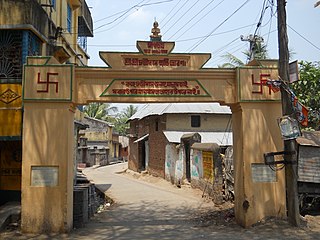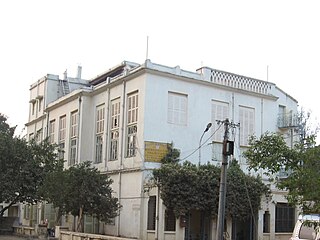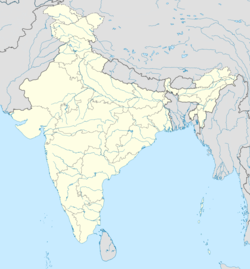
Shantiniketan is a neighbourhood of Bolpur town in the Bolpur subdivision of Birbhum district in West Bengal, India, approximately 152 km north of Kolkata. It was established by Maharshi Devendranath Tagore, and later expanded by his son, Rabindranath Tagore whose vision became what is now a university town with the creation of Visva-Bharati.

Visva-Bharati, is a public central university and an Institute of National Importance located in Shantiniketan, West Bengal, India. It was founded by Rabindranath Tagore who called it Visva-Bharati, which means the communion of the world with India. Until independence it was a college. Soon after independence, the institution was given the status of a central university in 1951 by an act of the Parliament.

Birbhum district is an administrative unit in the Indian state of West Bengal. It is the northernmost district of Burdwan division—one of the five administrative divisions of West Bengal. The district headquarters is in Suri. Other important cities are Bolpur, Rampurhat and Sainthia. Jamtara, Dumka and Pakur districts of the state of Jharkhand lie at the western border of this district; the border in other directions is covered by the districts of Bardhaman of Purba Bardhaman, Paschim Bardhaman and Murshidabad of West Bengal.

Bolpur is a city and a municipality in Birbhum district in the state of West Bengal, India. It is the headquarters of the Bolpur subdivision. Bolpur municipal area includes Santiniketan. The city is known as a cultural and educational hub of West Bengal. The city is under the jurisdiction of Bolpur and Santiniketan Police station. Bolpur is the largest and most populous city in Birbhum district and 28th most populous city in West Bengal. Located on the banks of Ajay River and Kopai River, Bolpur has been a major human settlement. It is 150 km north of Kolkata and is famous for Visva Bharati, the University set up by the Nobel laureate poet Rabindranath Tagore.

Mukul Chandra Dey was one of five children of Purnashashi Devi and Kula Chandra Dey. He was a student of Rabindranath Tagore's Santiniketan and is considered as a pioneer of drypoint-etching in India. The entire family of Mukul Dey had artistic talents, the brother Manishi Dey was a well-known painter, and his two sisters, Annapura and Rani Chanda, were accomplished in arts and crafts as well.

Poush Mela is an annual fair and festival that takes place in Santiniketan, in Birbhum District in the Indian state of West Bengal, marking the harvest season. Commencing on the 7th day of the month of Poush, the fair officially lasts for three days, although vendors may stay until the month-end as per the university regulations. From 2017 onwards, the fair lasted for six days. The key characteristic of this fair include live performances of Bengali folk music, such as baul, kirtan and Kobigan.
Labhpur is a census town in Labpur CD block in Bolpur subdivision of Birbhum district in the Indian state of West Bengal. It is known to the outside world as the native place of Tarashankar Bandopadhyay and one of the 51 Shakti Peethas.
Kirnahar is a village in Nanoor CD block in Bolpur subdivision of Birbhum district in the Indian state of West Bengal.

Nanoor, is a village in Nanoor CD block in Bolpur subdivision of Birbhum district in West Bengal. Nanoor is the birthplace of 14th century lyric poet Chandidas of Vaishnava Padavali fame. It is developing as a craft centre with NGO support. With the massacres in 2000, Nanoor was in intense media focus.

Hetampur is a large village in Suri Sadar subdivision of Birbhum District in the Indian state of West Bengal. It is situated near Dubrajpur. The village is famous for the Royal and historical palace.
Ilambazar is a census town, with a police station, in Ilambazar CD block in Bolpur subdivision of Birbhum district in the Indian state of West Bengal.

Bolpur Subdivision is an administrative subdivision of Birbhum district in the state of West Bengal, India.
Jaydev Kenduli is a village and gram panchayat in Ilambazar community development block in Bolpur subdivision of Birbhum District in the Indian state of West Bengal. It is believed by many to be the birthplace of Jayadeva, an issue that is still debated by scholars. It has developed as a religious centre with many temples and ashramas (hermitages). An annual fair, popular as baul fair, is organized on the occasion of Makar Sankranti.

Kankalitala is a temple town in Bolpur Sriniketan CD block in Bolpur subdivision of Birbhum district in the Indian state of West Bengal.
Sriniketan is a neighbourhood of Surul in Bolpur subdivision of Birbhum district in the Indian state of West Bengal. It is adjacent to Santiniketan and houses the second campus of Visva-Bharati University. The Palli Samgathana Vibhag and Palli Siksha Bhavana are located in west bengal
Raipur is a village under Raipur–Supur gram panchayat of Bolpur Sriniketan block in Bolpur subdivision of Birbhum district in the Indian state of West Bengal.
Khustigiri is a village in Ilambazar community development block in Bolpur subdivision of Birbhum District in the Indian state of West Bengal. It is 25 kilometres (16 mi) from Suri.

Bolpur Sriniketan is a community development block that forms an administrative division in Bolpur subdivision of Birbhum district in the Indian state of West Bengal.
Khujutipara is a village in Nanoor CD block in Bolpur subdivision of Birbhum district.
Parota is a census town in Nanoor CD block in Bolpur subdivision of Birbhum district.















